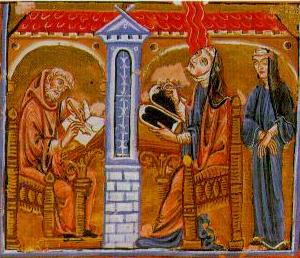
Saint Hildegard of Bingen is getting some press these days. Many are very curious to know how and why the Pope did such an unusual thing in making her cult as concrete as possible. Being inscribed as a saint in the album of the saints is pretty concrete, I'd say.
The Church's official teaching is seen by the use of concepts like "extension of Hildegard of Bingne's cult to the entire Church," meaning that she is proposed as a model of holiness with moral certainty to the faithful. Remember, only the Blessed Trinity is worshiped at the Liturgy. Saints and Blesseds are venerated, honored. Not the same. Hence, the definition of "cult" in Catholic theology is that the veneration saints particularly at the sacred Liturgy (i.e., the worship of God at Holy Mass, Lauds and Vespers) is made possible by the Church recognizing that this person is with God in heaven and is a reliable witness for Christian living.
For a long time Hildegard's been called "saint." And, so, some may say, "It's about time" the Church made this fact official. Perhaps it wouldn't make a difference if she was officially added to the canon of saints, but there is a certain relief that the Church has settled the cause. It has to be acknowledged that in the 800+ years since Hildegard's death, her cause for canonization must be one of the higher profile ones around. And for whatever reason Hildegard's cause wasn't completed until recently. What we've been given by the Tradition is that Hildegard has been known as a saint, her writings, and her many ecclesial contributions are well-regarded. It is also well-known that the Pope has spoken eloquently of Hildegard a few times in the past years; hence he decided to end the ambiguity of her ecclesial status, writing her name "in the album of the saints." Some would say that Benedict's gesture rehabilitates Hildegard's place in Church and state. While that may be an overstatement, he did "do good by her."
Our newest saint is revered by the Anglo-Catholics, so this is another point of connection with those who hold the Anglican patrimony in high esteem.
You may want to read Nathaniel M. Campbell essay on his blog Fides Quaerens Intellectum.
Some things to read:
Augustine Thompson, OP, "Hildegard of Bingen on Gender and the Priesthood" and Dr. Leroy Huizenga's First Things essay published, Hildegard of Bingen: "Saint of the Universal Church"
Hildegard von Bingen with Richardis von Stade (right) and Volmar (left). Miniature painting, c. 1230; Lucca, Biblioteca Statale


Leave a comment